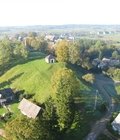The mound dates from the 1st millennium to the 13th century. Here was a Curionan Castle Gardai, mentioned in 1253. The mound stands on the right bank of Varduva and in confluents with the Pagardenis (Cedrono) river. According to the legend, Samogitians were baptized along the Varduva stream. The baptized people received new names, for this reason the river was called Varduva (in Lithuanian base “vard” is the same as for the word “name”) and the nearby mountain - St. John the Baptist's Hill.
Grand Duke of Lithuania Vytautas made this land to the Bishop of Samogitia as a present in 1417. In between 1633 – 1649 this Bishop was Jurgis Tiškevičius, who is considered to be the founder and promoter of the path of suffering. When exactly the first chapel was built, it is not known. It may be the case that in 1637 by inviting the Dominicans to settle down in Gardai, the bishop already fostered such an idea. It is known that in 1639 Bishop J. Tiškevičius received a feast from the Pope Urbonas XVIII for six chapels of Calvary: the Last Supper, the Olive Garden, Christ's Beasting at the Pole, the Trimming of the Trinkets, the Crucifixion and the Burial of Christ. At that time, the Calvary was probably partially functioning. It is estimated that all presently located chapels in Samogitian Calvary were built around 1640.
There is evidence that hills and places for chapels were appointed by Bishop J. Tiškevičius himself, he counted steps from one place to another, so that there would be as much of them as Jesus had walked during his suffering. When walking for the first time and in many places doing this on his knees, the Bishop strewed the paths of Suffering with the land brought from Jerusalem. To glorify the place, he called Gardai a New Jerusalem, however the name did not naturalize, therefor the town was simply called Samogitian Calvary.
Between 1637 and 1639, when the Chapels of the Cross Road were being built, St. John's hill was wrecked.

+1



Reviews